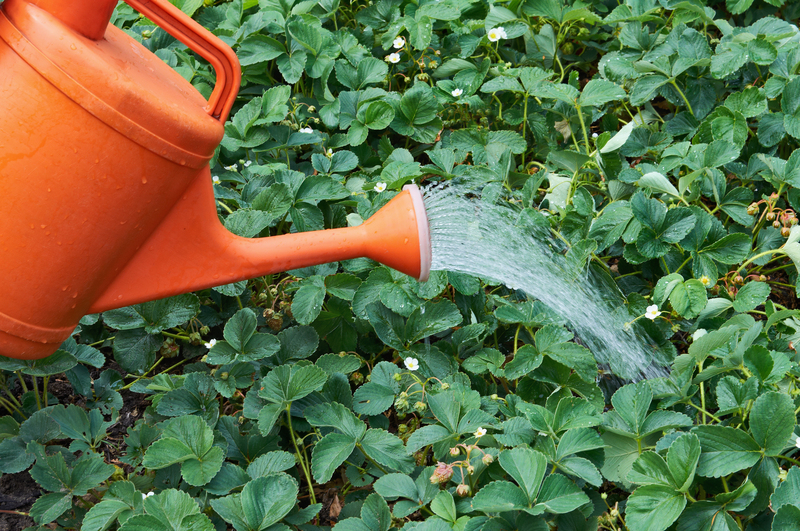Embracing the Breeze: Managing Wind in Your Garden
Posted on 25/06/2025
Embracing the Breeze: Managing Wind in Your Garden
Wind--a quietly powerful force in our daily outdoor experiences--can bring gentle refreshment or challenging chaos to a garden landscape. While a gentle breeze invites pollinators and cools the plants, strong gusts may dry out soil, snap branches, or even uproot your favorite blooms. Embracing the wind instead of resisting it offers both creative and functional opportunities for transforming your gardening experience. Are you ready to make the wind work with you, not against you? In this in-depth article, we'll discuss managing wind in your garden for thriving plants, stunning design, and a more enjoyable outdoor space.
Understanding the Impact of Wind on Gardens
Before you can effectively manage wind in your garden, it's important to understand how it affects your plants and microclimate. Wind, depending on its direction and speed, can either benefit or damage a garden.
Benefits of Gentle Breezes
- Promotes Air Circulation: Gentle winds circulate air, reducing humidity and helping to prevent plant diseases such as mildew and fungus.
- Pollination Assistance: Many plants rely on wind for pollination. Grasses, corn, and even some fruit trees benefit from breezy conditions.
- Strengthening Plants: A mild breeze encourages plants to develop stronger stems, making them more resilient overall.
Challenges from Strong Winds
- Desiccation: Persistent wind can dry out soil, removing vital moisture needed for healthy growth.
- Physical Damage: Fierce gusts may break stems, strip leaves, and, in extreme cases, uproot plants.
- Soil Erosion: Wind can carry away valuable topsoil and nutrients, making it difficult for roots to establish.
It becomes clear that wind management in the garden is essential for protecting your landscape and encouraging robust growth.

Assessing Wind Conditions in Your Garden
Every garden is unique. The way wind moves through your space will depend on orientation, location, topography, and nearby structures. Consider these steps to analyze wind patterns for smarter garden planning:
- Observe Wind Direction: Spend several days noting which direction the strongest breezes come from, especially during different seasons.
- Identify Trouble Spots: Look for areas where plants appear windburned, soil is consistently dry, or leaves collect against fences.
- Check for Microclimates: Examine how fences, sheds, or trees deflect or concentrate wind, creating pockets of calm or turbulence.
Mapping wind movement will help you design effective strategies for embracing and managing wind in your garden.
Designing Your Garden to Work With the Wind
With your garden's wind profile understood, you can implement practical design solutions to protect your plants and create a more harmonious landscape. Here are smart approaches for managing breezes and sheltering sensitive species:
Create Effective Windbreaks
Windbreaks, also known as shelterbelts, are barriers--natural or constructed--that reduce wind speed. When designed correctly, they can:
- Decrease the force of wind by up to 50% or more
- Help retain soil moisture and prevent erosion
- Encourage the formation of beneficial microclimates
Living Windbreaks
Shrubs, hedges, and trees are the most attractive and eco-friendly forms of windbreaks. For the best results, consider:
- Layering: Combine tall and low-growing plants in multiple staggered rows for the most effective barrier.
- Density: A windbreak that is too dense will cause turbulence; instead, aim for 50-80% permeability to buffer wind without creating damaging eddies.
- Plant Choices: Choose hardy, flexible species suited to your local conditions (e.g., arborvitae, privet, holly, yew, or pine).
Tip: A mixed species hedge provides year-round protection, biodiversity, and added beauty.
Fences and Garden Structures
When living windbreaks aren't practical, fencing and screens can offer targeted relief:
- Lattice or slatted fences: These allow some wind through, reducing uplift and damage. Solid fences can increase turbulence.
- Trellises with vines: Clematis, honeysuckle, and climbing roses double as living screens that break the breeze and add color.
- Pergolas and arbors: Useful for sheltering seating areas and delicate plants, while softening wind effects.
Embrace a combination of living and constructed windbreaks for versatility, beauty, and optimal wind management in your garden.
Strategic Plant Placement
Not all plants are equally susceptible to wind damage. Manage breezes by grouping plants based on their tolerance:
- Tuck tender species behind windbreaks or denser shrubs to shield them from direct blasts.
- Use sturdy, flexible plants (e.g., ornamental grasses, lavender, juniper) as a frontline defense.
- Cluster pots and containers in protected corners, grouping them together for mutual shelter.
Plant Choices for Windy Gardens
Selecting the right plants is a key aspect of successful wind management in your garden. Some plants naturally thrive in exposed, breezy locations:
Top Plants for Wind Resistance
- Ornamental Grasses: Maidengrass, feather reed grass, blue fescue sway gracefully without snapping.
- Conifers: Pine, spruce, juniper offer evergreen structure and flexibility.
- Sea or Beach Plants: Sea thrift, beach daisy, sea holly, adapted to coastal exposure.
- Woody Perennials: Lavender, rosemary, hebe, hardy fuchsia stand up to the breeze.
- Climbers: Honeysuckle, clematis, climbing hydrangea, if secured properly, make wind-resistant green screens.
Remember: Native plants are often best suited to withstand local winds and can enhance your efforts when managing wind in your garden.
Soil, Mulching, and Moisture Management
Wind doesn't just impact the upper parts of your garden--it can dry and erode soil as well. Here's how to counteract wind effects at root level:
- Mulching: Thick layers of wood chips, straw, or compost help conserve moisture and prevent soil loss.
- Groundcovers: Use creeping or low-growing plants to hold soil in place and protect roots from wind exposure.
- Soaker hoses and drip irrigation: These minimize evaporation compared to overhead watering.
Wind-driven gardens will often need more frequent monitoring--even drought-tolerant plants may require supplemental moisture during dry, breezy spells.
Staking and Supporting Vulnerable Plants
Young trees, tall perennials, and vegetables often need extra support in wind-exposed gardens:
- Stake trees loosely with elastic ties--this allows gentle movement, which encourages sturdy trunk development.
- Use canes, hoops, or cages to steady tall, floppy plants like delphiniums, tomatoes, or sunflowers.
- Check supports regularly and loosen ties as stems grow to avoid constriction.
Proper staking prevents physical damage and ensures your plants flourish despite the breeze.
Embracing Wind for Garden Health and Beauty
Managing wind in your garden isn't about erasing its presence but rather about working alongside this natural force. Harnessing the positive aspects of wind can actually improve your growing conditions:
- Natural cooling and ventilation reduce overheating and keep fungal problems at bay.
- Inviting pollinators and seed dispersal agents increases garden biodiversity.
- Sculptural possibilities as you select plants and structures that dance and sway artistically.
Choosing flexible plantings, designing smart windbreaks, and maintaining healthy soil will help you embrace the breeze for a more resilient and beautiful home landscape.
Innovative Ideas: Using Wind as a Garden Feature
Want to go beyond simple protection? Turn wind into a garden asset by including:
- Wind chimes and kinetic sculptures: Add soothing sound and movement.
- Spinning art or pinwheels: Fun for children and adults alike, while adding visual interest.
- Ornamental grasses and tall perennials: Plant them where their motion can be enjoyed from seating or window views.

Frequently Asked Questions about Managing Wind in the Garden
How can I protect my vegetable garden from wind?
Erect mesh fencing or plant a row of sunflowers, corn, or sturdy beans as a living windbreak. Mulching your beds and using supports for taller veggies adds resilience against gusts.
What are the best wind-tolerant trees for small gardens?
Consider slower growing or compact varieties like Amelanchier, crabapple, hawthorn, or serviceberry which combine ornamental value with wind resistance.
Can I grow fruit trees in a windy garden?
Yes--choose trained forms (espalier, cordon) and sturdy rootstocks. Protect new trees with shelters or stakes, and plant in a protected microclimate if possible.
Will a solid fence stop the wind?
Not effectively--a solid fence can cause damaging turbulence. Permeable screens or hedges are more effective at slowing wind.
Conclusion: Creating Success by Embracing the Breeze
Managing wind in your garden is a holistic process requiring observation, smart design, resilient plant choices, and ongoing care. By embracing the breeze, rather than fearing it, you open up possibilities for dynamic landscaping, healthier plants, and even unexpected joys--from dancing grasses to melodious chimes.
Start by learning your unique wind patterns, then create multi-layered defenses with windbreaks, smart plant placement, and soil care. Introduce elements that transform wind into a garden feature, and enjoy a space that thrives no matter which way the wind blows. Let the breeze inspire you as you grow a stronger, more beautiful garden!

